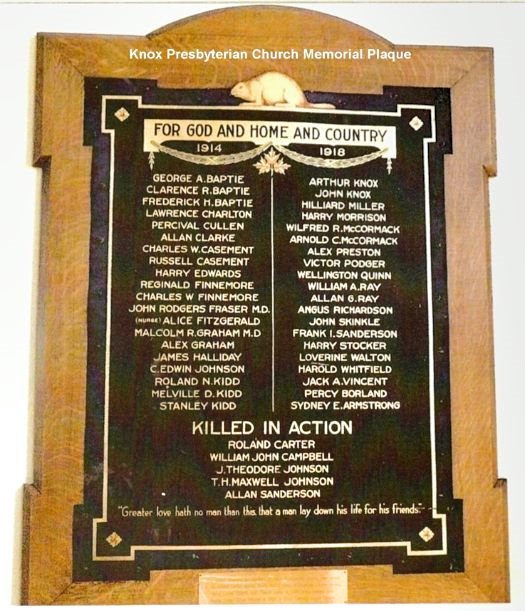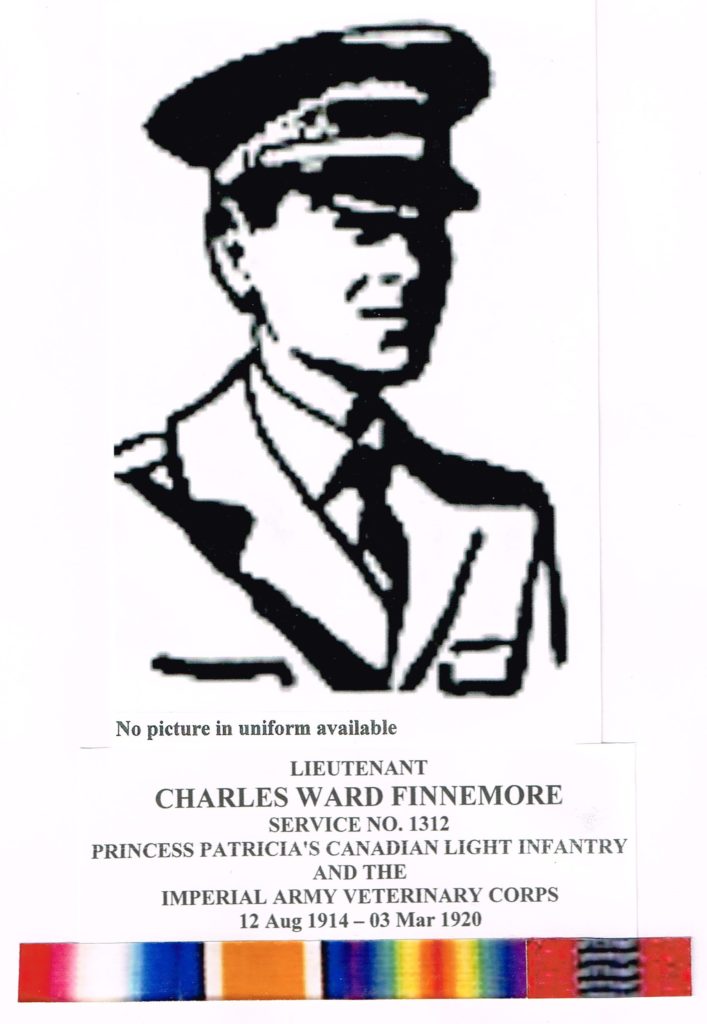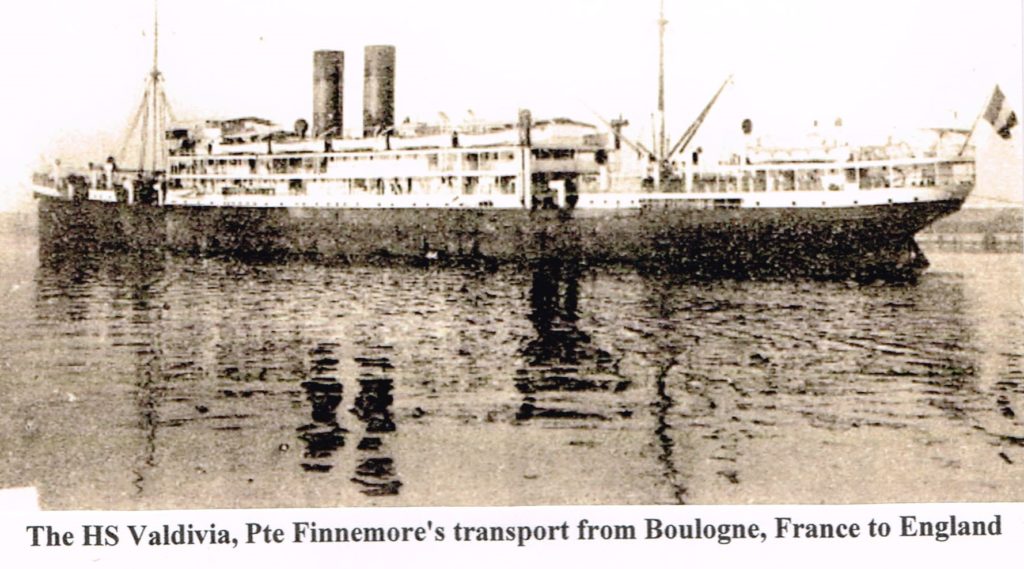MILITARY HISTORY
Lieutenant Charles Ward Finnemore — 1312 — ACTIVE SERVICE (World War I)
Charles Ward Finnemore was 50 years and 4 months old when, as a married man, he Enlisted in Ottawa, Ontario on August 12, 1914 with the Princess Patricia’s Canadian Light Infantry (PPCLI), No 3 Company CEF for the duration of the War. Charles Ward was Attested in the Canadian Army (CA), Canadian Expeditionary Force (CEF) in Lévis, Québec and was born in London, England on April 14, 1864. He was 5′ 10½” tall, dark complexion, brown eyes, grey hair and had a 38″ chest (expanded); he weighed 185 pounds. Charles Ward gave his occupation as a Veterinary Surgeon and he was a Veterinary Inspector with the Agriculture Department at time of enlistment; Charles Ward’s next-of-kin was his daughter Mrs. Lillian Etta Ward Finnemore living at 7 Marion St., Parkdale, Toronto, Ontario. His wife Sarah Annie had died in 1902. He indicated that he had no previous Militia Force but 3 years and 221 days with the 2nd Dragoons Military Force from Southern Ontario. Charles Ward’s Medical Examination was done in Lévis, Québec on September 2, 1914, Pte Finnemore had a scar from a wound on his left thigh and sword cut in his cheek. He was found fit for duty. On September 1, 1914 Charles Ward initiated a Separation Allowance Payment of $20.00 monthly to his wife living at 7 Marion St., Parkdale, Toronto. On September 18, 1914 he was assigned the Rank of Private (Pte); given Regimental Number 1312 and taken-on-strength to the PPCLI Depot CEF. The Certificate Of Officer Commanding Unit was signed by the Lieutenant Colonel Commanding the PPCLI on October 5, 1914.
On October 3, 1914 Pte Finnemore embarked the SS Royal George from Quebéc for England. He would have disembarked at England about October 14, 1914.
Although not stated in his File, Pte Finnemore was promoted to the Rank of Acting Sergeant (A/Sgt); perhaps in October 1914.
December 20, 1914 A/Sgt Finnemore embarked at Southampton, by the War Office (WO), to France. January 1, 1915 A/Sgt Finnemore was promoted to the Rank of Sergeant (Sgt), effective December 26, 1914), through the CHQ (Corps Headquarters), 3rd Battalion (Bn). January 7, 1915 he was admitted to the 83rd Field Ambulance (FA) Royal Army Medical Corps (RAMC) with an injury to his head and spine from being kicked by a horse, he subsequently was moved to the Orthopedic General Hospital. January 9, 1915 Sgt Finnemore was admitted from the Orthopedic General Hospital to the No 2 British Red Cross Hospital at Rouen, France with an injury to his spine. January 15, 1915 he was transferred from the No 2 British Red Cross Hospital. January 17, 1915 Sgt Finnemore embarked the HS Valdivia at Boulogne and disembarked at England to the England Inquiry – Spine and was discharged on appointment to a Commission with the Imperial Army Veterinarian Corps (Authority – Army Postal Service Letter 121/F/11).
On March 8, 1915 Sgt Finnemore was 50 years and 10 months old, he was 5′ 10″ tall, had a dark complexion, brown eyes and grey hair. June 8, 1915 Sgt Finnemore is struck-off-strength from the 11th Reserve Battalion (Res Bn) on being appointed to a Commission with the Imperial Army, England. The above order is amended to read “Discharged with effect from June 8, 1915 on appointment to a Commission. On June 24, 1915 Sgt Finnemore was transferred to the 11th Res Bn and taken-on-strength at St. Martins Platoon (Ptn). From a Certificate of discharge from the Canadian CEF to the Imperial Army Veterinary Corps, dated June 24, 1915, he was struck-off-strength from the 11th Res Bn CEF and discharged at Shorncliffe in consequence of having been appointed to a Commission (Lieutenant [Lt]) in the Imperial Army Veterinary Corps. Authority; Director General Army Veterinary Services (AVS’s) 121/F/11 – Volunteer Officer’s Decoration (VD) after serving 210 days.
CHARACTER EXEMLARY was written across the page.
FOR OFFICERS ONLY
PROCEEDINGS OF A MEDICAL BOARD assembled
At Base Hospital, Toronto on the 9th Day of March, 1917. by order of
A. D. M. S., Mil. Dist. No 2.
for the purpose of examining and reporting upon the present state of health of
Lieut. C. W. Finnemore. (67 McDonald Ave., Toronto.)
Imp. Army Vet. Corps, BEF. (Late P.P.L.I., C.E.F.)
PRESIDENT …… Captain H. R. Holme., A. M. C.
| Captain C. W. Carleton A. M. C.
MEMBERS |
| Captain A. B. James., A. M. C.
The Board having assembled pursuant to order, proceeded to examine the
above-named officer and find that: While serving with the P.P.C.L.I., C.E.F. in
France, in February, 1915, he received injury to the brain and spine. On June 8th 1915 he was struck-off-strength to the Army Vet. Corps, British Expeditionary Force* (BEF). June 20, 1915 he volunteered for service in Egypt with the 69th Brigade (Bde) RFA, BEF. Invalided home from Egypt suffering from lapses of memory and paralysis. Volunteered again for service in France and sent to No 5 Veterinarian Hospital, was again invalided home in March 1916, was granted six months sick leave May 3rd 1916 and recommended to proceed to Canada by Medical Board at Caxton Hall. On May 15th leave was contracted to three months by Assistant Director of Veterinary Services (A. D. V. S.). In July 1916, was examined by Dr. Head, Brain Specialist, London General Hospital – July 20, 1916, was taken from Hospital to Livepool by Medical Officer who escorted him to Canada and placed in care of Lieut. R. W. Ensor who escorted to Canada and to his home in Toronto [about August 1, 1916]. In September 1916 he was examined by Medical Board in Toronto, (Major Carrie, President) and granted six months leave of absence.
* The BEF is an Army of more than 3,000,000 men established by the Government of Britain for service
Overseas.
PRESENT CONDITION: Since his arrival in Canada, he has been troubled with attacks of general
weakness and severe head-aches, with complete lapses of memory at regualar intervals of three or four
days. Head-aches practically leave him in a helpless state. Trouble on the right side with Hemiphlegia,
with partial loss of power of left hand and arm and walks with a decided limp and toe drop. Invariably in
weak condition in early morning. Appetite fair and loss of sleep at times. Hearing poor; right ear 10/40,
left ear, 10/40.
(1) Is the Officer fit for service? … No …….
(2) If not so fit, how long is the disability likely to continue? … Permanent ……..
RECOMMENDATION: … That he is unfit for further Military Service. ……………
(3) To what extent does his earning a livelihood? ….. 2/5. ……..
Approved by the Assistant Director Medical Services on March 10, 1917, signed by three Captains.
June 19, 1919; Lt Finnemore served with the PPCLI from August 12, 1914 to June 8, 1915 in England and France. On June 9, 1915 he served with the Imperial Army Veterinary Corps until August 20, 1916. His latest address is: Box 511, Lakefield Ontario
Lt Finnemore’s Military File is incomplete and difficult to decipher in a number of places. Bits of data have been listed together as no additional data was found to explain or confirm it. June 8, 1918 Lt Finnemore was struck-off-strength from the Imperial Service in England and taken-on-strength to the Canadian Army. At somepoint, usually on discharge, he would have been given his Post Discharge Pay of $172.62; there is no record of a War Service Grant. Lt Finnemore may have been given a Clothing Allowance and a Rehabilitation Grant. It is believed that Lieutenant Charles Ward Finnemore was discharge from the Canadian Army about March 3, 1920
There is no mention in Lieutenant Charles Ward Finnemore’s File with regards to what Military Medals he was eligible to receive or was awarded. Based on his Military Service, he was awarded the:
1914 – 15 Star;
British War Medal;
Victory Medal; and
Volunteer Officer’s Decoration.
He would have also received the CEF Class “A” and Class “B” War Service Badges.
Lieutenant Charles Ward Finnemore served for: 4 months, 12 days in Canada; 3 years, 8 months, 24 days in the United Kingdom; 28 days in France and 20 days Travel Time for a total time of 5 years, 6 months and 20 days. Included in his time served is 1 year, 10 months and 8 days with the PPCLI plus 1 year and 11 days with the Imperial Army Veterinary Corps.
An excerpt from an article in McLean’s magazine by Barbara Amiel, September 1996:
The military is the single calling in the world with job specifications that include a commitment to die for your nation. What could be more honorable?
PERSONAL HISTORY
CHARLES WARD FINNEMORE
Charles Ward Finnemore was born in London, England on April 14, 1864. Charles grew up in London, England and married Sarah Ann Challans, born 1859 in England, around 1890. They had a family of four children; Reginald was born November 12, 1896 in England; the youngest child. Sadly Sarah Annie died in 1902 and is interred in Farndon, Chestershire, England.
In 1908 Charles and his son Reginald, daughter Lillian Etta and another daughter immigrated to the United States and around 1911 crossed into Canada settling in Toronto. Shortly after Charles was one of the oldest students enrolled in the Ontario Veterinary College at the University of Toronto graduating as a Veterinary Surgeon.
Charles had previous military experience serving with the 2nd Dragoon Guards for three and a half years. When the First World War broke out, Charles enlisted from Levis, Quebec to serve his King and Country on September 18, 1914. At some point, Charles married for a second time to Katherine “Kate” Unknown. Charles son Reginald served in the Canadian Army Service Corps in 1916. On September 15, 1917, Charles’ daughter, Lillian Etta Finnemore, was married in Toronto, Ontario to James Gordon Campbell, son of Robert Campbell and Evelyn Smith.
On June 25, 1919 Charles’ son, Reginald Finnemore accidentally drowned while working on the construction of the Welland Ship Canal. At the time of his drowning he was working in Port Weller and may have been engaged in the new harbor works. The Finnemore family may have came to Lakefield sometime after 1911. The 1921 Census of Canada indicates that Charles and his wife Kate were living on Bridge Street in Lakefield. Charles was working as a veterinarian and they were members of Knox Presbyterian Church.
James “Gordon” Campbell died in 1956 and his wife Lillian Etta Finnemore died in 1989; both are buried in Greenwood Cemetery in Burlington, Ontario. Charles Ward Finnemore died on June 7, 1941 and his wife Katherine died on May 30, 1963; both are buried in Mount Pleasant Cemetery, Toronto, ON.
Reginald came to the United States in 1908 with his father and two sisters. The family would later cross into Canada and settle in Toronto, where at age 50 his father was one of the oldest students in the Ontario Veterinary College, University of Toronto.
Soon after the outbreak of the First World War, Charles Ward Finnemore enlisted for service. According to his gravestone, Reginald also served in the military (Canadian Army Service Corps in 1916), though no official record of his service has been found.
After the War, Reginald Finnemore worked on the Welland ship canal as a labourer. The job of labourer was so diverse that it is difficult to say what tasks Finnemore would have undertaken, but he was working in Port Weller at the time of his death so he may have been engaged in the new harbour works.
Sadly, little information is given about Reginald Finnemore’s death. The only details that have survived are from his death certificate and from a brief newspaper article which gave June 25, 1919 as the date of his death.
These two sources note he died from drowning. Because of this cause of death, the coroner decided there was no need for an inquest.
THE CHARLES WARD FINNEMORE FAMILY OF LAKEFIELD
No data has been found for Charles Ward’s parents nor grandparents.
Charles Ward Finnemore was a member of Knox Presbyterian Church and is included on a Memorial Plaque that hung in Knox Presbyterian Church which remembers with honour their members who served in the Armed Forces during World War I. This plaque was later moved to the Sanctuary of Lakefield United Church on Regent Street in 1932 after the two churches merged to form Lakefield United Church.




